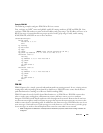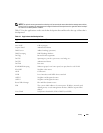
Utility 163
– The hostname of the TFTP server (option 66 or sname). Either the TFTP address or name is
specified (not both) in most network configurations. If a TFTP hostname is given, a DNS server is
required to translate the name to an IP address.
– The IP address of the TFTP server (option 150).
– The address of the TFTP server (siaddr) to be used for Auto Config requests.
No configuration assigned by BOOTP or DHCP is saved in startup-config.
A DNS server is needed to resolve the IP address of the TFTP server only if the sname or option 66 values
are used.
Obtaining a Config File
After obtaining IP addresses for both the switch and the TFTP server, the Auto Config process attempts to
download a configuration file. When possible, a host-specific configuration file is downloaded. Otherwise,
a network configuration file is used to get the final configuration. The process is described below.
The switch attempts to download a host-specific configuration file if a bootfile name was specified by the
DHCP or BOOTP server. The switch makes three unicast TFTP requests for the specified bootfile. If the
unicast attempts fail, or if a TFTP server address was not provided, the switch makes three broadcast
requests to any available TFTP server for the specified bootfile. A TFTP broadcast request is a simple
TFTP request with broadcast destination MAC address (ff:ff:ff:ff:ff:ff) and destination IP address
(255.255.255.255).
NOTE: The bootfile is required to have a file type of *.cfg.
Attempts are made to download a default network configuration file with the name "fp-net.cfg" when:
• the host-specific bootfile cannot be found.
• a failure occurs in the host-specific configuration file download.
• the switch was not provided a specific bootfile name by the DHCP server.
The switch unicasts or broadcasts TFTP requests for a network configuration file in the same manner as
the attempts to download a host-specific configuration file.
The default network configuration file should have IP address to hostname mappings using the
command ip host <hostname> <address>. If the default network configuration file does not contain
the switch's IP address, the switch uses DNS to attempt to resolve its hostname.
A sample fp-net.cfg file follows:
config
...
ip host switch_to_setup 192.168.1.10
ip host another_switch 192.168.1.11
... <other hostname definitions>
exit


















